Sites
Overview
A Site represents a physical install location for one or more Gateways in Edge Direct. Using Sites to organize your Gateways allows you to configure firmware settings for those assigned Gateways from one place in the user interface. A Site may contain many Gateways and Devices, but each Gateway may only be assigned to one Site.
Gateways that are not in a site may be managed and configured individually. For more on this see Configuration
Each Site contains the following components:
Details: This view will provide context information about the Site. All information shown is configurable after Site creation except for the Site name.
Maintenance Window: This component is mandatory for each Site. The default maintenance window is "immediate/ongoing", which means that all configuration changes are immediately made available for Gateways to apply as they are released.
Configuration: A Site enables users to configure many Gateways at once. Sites use Configuration States to manage this. For more information on the different types of configurations, as well as an in-depth explanation of how a configuration moves from state to state, see Configuration
Gateways: A list of Gateways in the Site.
Devices: A list of all Devices in the Site.
Tags: A flexible mechanism for labeling and attaching data to Sites. See Tags for more information.
Site List View
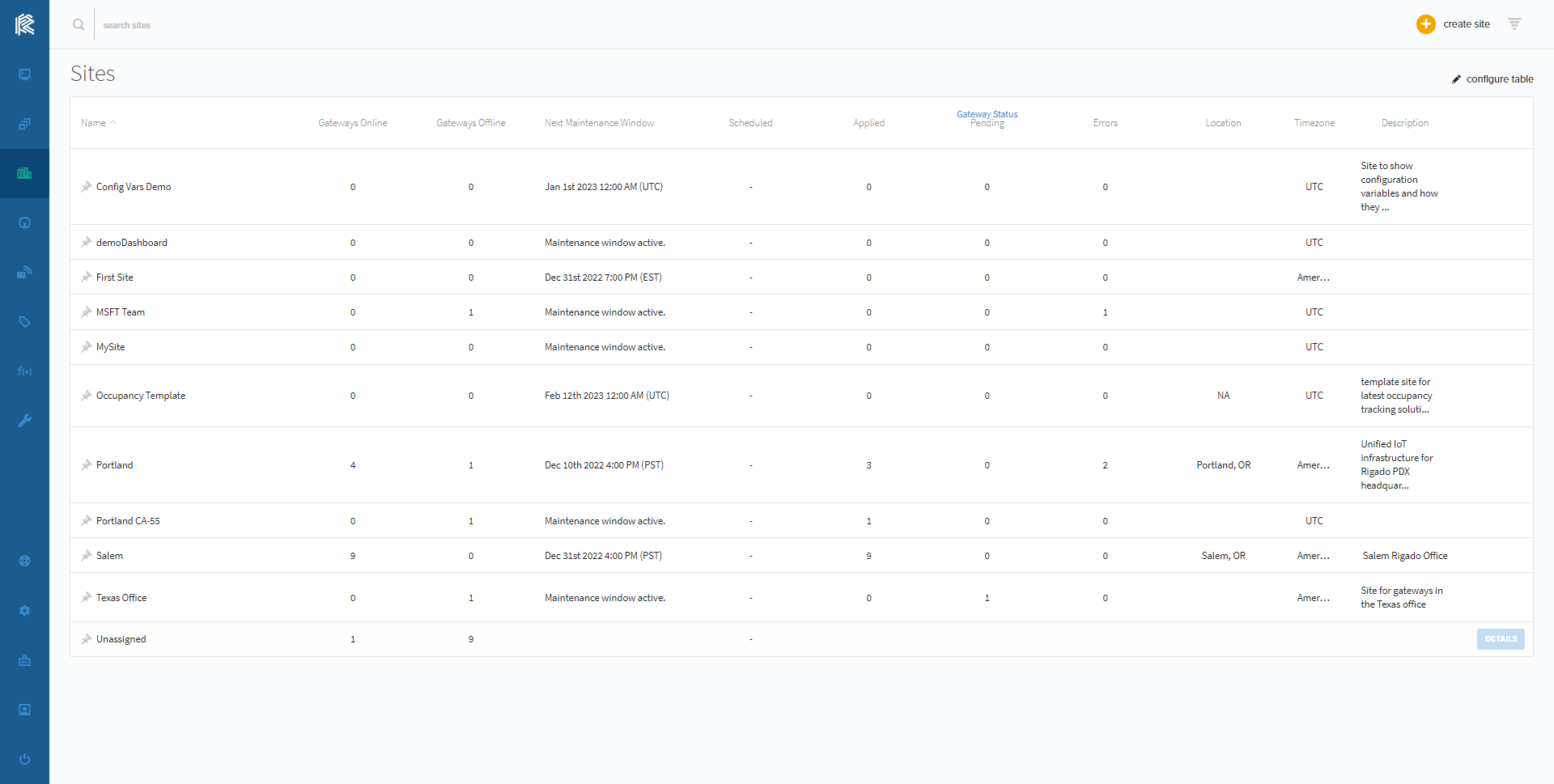
The Site page lists all available Sites. It shows a summary of each Site's Gateway status and configuration status, as well as a summary of the current or upcoming maintenance window.
Clicking on a Site will bring up the Site detail view.
Site Detail View
When opening a Site, the first pane that will load is the Details view. This provides users with an overview of Site installation and context data.
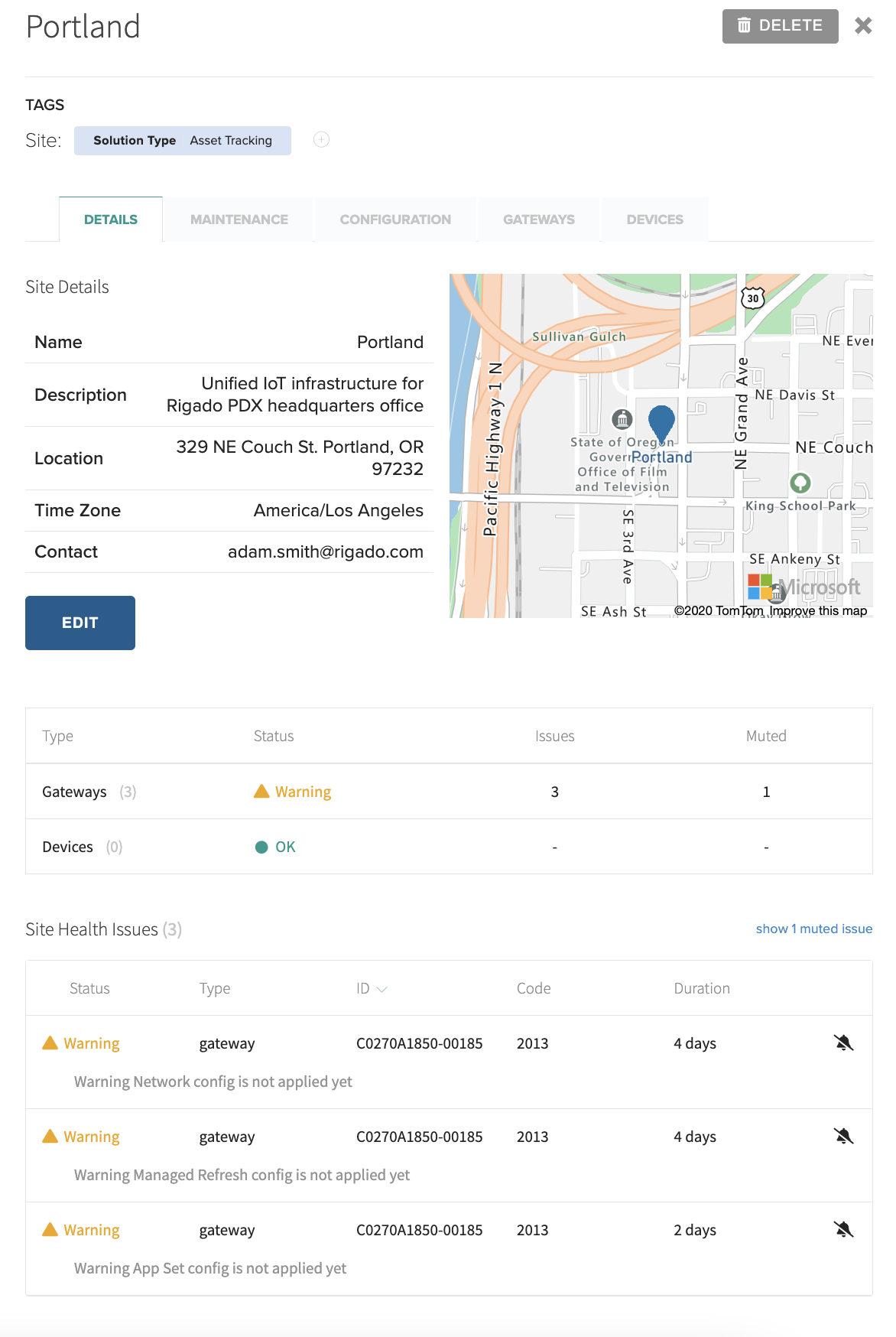
The Site detail view shows the Site's basic information, such as tags, description, location, and timezone. It also allows the user to update this information.
Name: The user generated name of the Site, this cannot be changed after creation.
Tags: Tags can be added to show up at the top of the Site display by clicking the small + symbol under "Tags" below the Site Name. For more information on this see Tags and Tag Keys.
Description: An optional description of the Site for users to provide context information.
Location: An optional location for the Site. This value is used for description and mapping of the Site.
Time Zone: An optional time zone setting for the Site. This value is used for showing Site-related timestamps in the Site's local time.
If a timzeone is not specified, all Site-related timestamps will display in UTC time.
Contact: Site Contact can be selected from a list of users with Administrator or Site Owner with access to a Site. This is also an optional field, but it is encouraged to assign a Site Contact for escalation of issues both internally and with Rigado support.
Site Map: Displays the location of the Site, this is based on the information provided in the Location field.
Site Health
In the Site Details view there are two tables that provide insight to the overall health and issues present.
Site Health Status Overview
The first Table provides an overview of the status and number of issues related to Gateways and Devices. From this table you can quickly see:
- Issues by hardware type
- Total number of Gateways and Devices in the parenthesis
( )next to each type - Roll-up status of hardware by type. Severity level of status is inherited from the respective Device and Gateways reporting
- Total number of Issues across all hardware
- number of Muted issues not included in the roll-up health status

Site Health Issues
The Site Health Issues table provides detailed Issue information and allows you to manage & navigate to the issue directly. Each issue will provide a Status, Issue Code, Duration of time in issue state, and a detailed message about the issue. For more details on Issue codes and resolution see the Issue Codes documentation.
Note: Clicking an issue on this table will navigate directly to the Gateway/Device impacted & specific issue selected.

Issues will remain present in the UI until Edge Direct verifies the issue is fully resolved. It can take up to 10 minutes before some issues are cleared from the time changes are applied.
Health Issue Muting
Issues can be managed through the Muting toggle button. This allows users to remove a known issue from the issue reporting and roll-up logic that calculates overall Site health. When Muting an issue Edge Direct will ask the user to confirm this action in a pop-up. After an item is Muted, it is still accessible from the "show X muted issues" button at the top right of the Health Issues table. This will toggle the entire list between muted and unmuted issues and allow users to view and unmute any issue.
Muting and unmuting of issues can be done in both the Site and impacted Gateway/Device Site Health issue tables.
Maintenance Windows
Maintenance Windows limit when updates can be applied to Gateways and provide a mechanism to prevent changes being pushed to Gateways outside of that period.
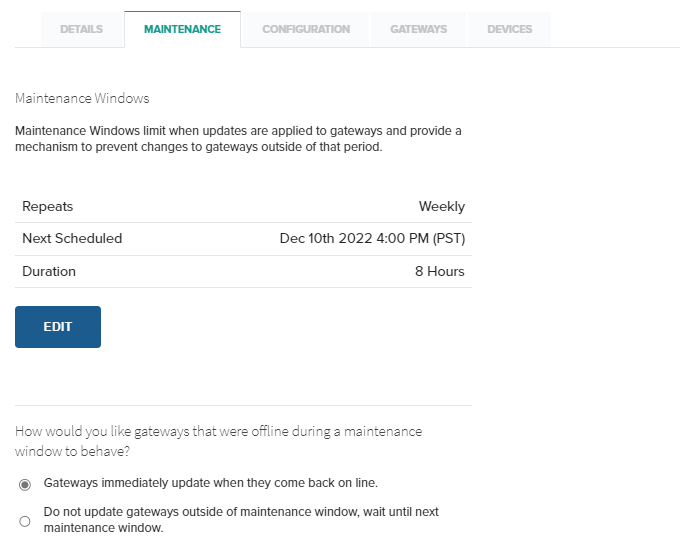
The Site Maintenance Windows tab shows the details of the Site's maintenance window, as well as the Gateway behavior settings related to that window.
The four types of maintenance window are:
- immediate/ongoing: Sites with this cadence will make
configuration changes available to Gateways immediately.
A Gateway must be online in order to apply configuration changes. For more detail on how configurations are applied, see Configuration.
-
weekly: Sites with this cadence will make configuration changes available to Gateways once per week, for a defined duration. You may specify the day of the week and the hour of the day (in UTC time) that the window will open.
Example: "Every Wednesday at 03:00 UTC"
-
monthly: Sites with this cadence will make configuration changes available to Gateways once per month, for a defined duration. You may specify the week of the month, day of the week, and hour of the day (in UTC time) that the window will open.
Example: "2nd Wednesday of the month at 03:00 UTC"
-
quarterly: Sites with this cadence will make configuration changes available to Gateways once every three months, for a defined duration. You may specify the month of the quarter, week of the month, day of the week, and hour of the day (in UTC time) that the window will open.
Example: "2nd Wednesday of the month (Months: February/May/August/November) at 03:00 UTC"
A Maintenance Window's duration may not be shorter than 8 hours. This is to allow time for each Gateway to receive updates, and for administrators to catch and correct potential errors with these changes.
A Maintenance Window's duration may not be longer than 24 hours. If you wish to have your Site's maintenance window open longer than 24 hours, consider updating it to an "immediate/ongoing" cadence.
The other setting on this tab is about updating Gateways that were offline during a maintenance window. If set to "immediately" then Gateways that come online after a maintenance window has already closed will receive the updates from that window. If set to "during next maintenance window" then those Gateways will not receive any updates until the next maintenance window opens.
If a Gateway is offline during a maintenance window when it comes online afterwards, and the Site is set to update this Gateway immediately, the Gateway will receive and apply these current configurations.Additionally, Gateways newly-added to a Site will immediately have the Site's current configurations applied to them, regardless of the Site's maintenance window.
Maintenance Windows can be overridden manually by authorized users. Whenever a Configuration update is submitted Edge Direct a pop-up prompt will ask if you'd like to override the Maintenance Window or queue the change. Queue will be the default, if you choose to override you will need to manually type in Authorize into the pop-up prompt.
Configuration
Configurations enable remote management of Gateways & Containers at scale. Edge Direct securely stores copies of all Configurations in the cloud, which allows users to queue and schedule deployment of updates and setting changes automatically. For more details see Configuration.
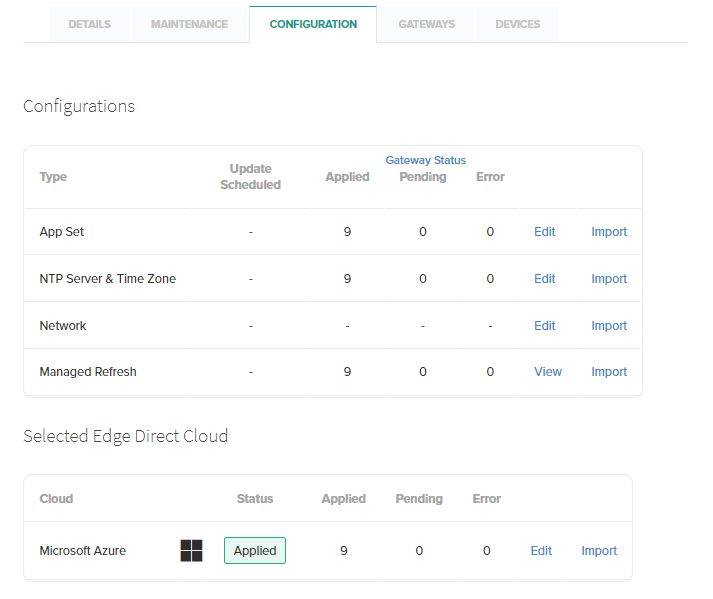
Configurations Table
The Configurations table of the Site detail view displays:
-
A table breakdown of configurations by type and by state, with a number of Gateways that currently have that configuration state.
- Editable table rows have an Edit button to schedule new configurations of that type for the next Maintenance Window.
- All configuration types have an Import button to copy the current configuration from another Site at current time of import. Configurations updated this way will still be scheduled like Editing.
- The Update Scheduled column will show "Yes" if a new configuration is scheduled to be applied at the next Maintenance Window.
-
A list of current configurations by type with aggregate number of Gateways in the Site in that state.
Edge Direct Cloud
The Edge Direct Cloud Sets which set of cloud hosts the Gateways use to communicate with Edge Direct. There are two options to choose from: Microsoft Azure and Amazon Web Services. For more details Prerequisites for more details.
Configuration Variables
A Site's configuration applies to many Gateways. Using Configuration Variables allows users to substitute individual values into that configuration at a Site or Gateway level. The Site Configuration Variable section allows defining Variables to be used in the configuration, and set Site-wide defaults if desired. Site Configuration Variables allow users to set specific Variables to "required", where a configuration will flag an error if a value is not set. For more information see Configuration Variables
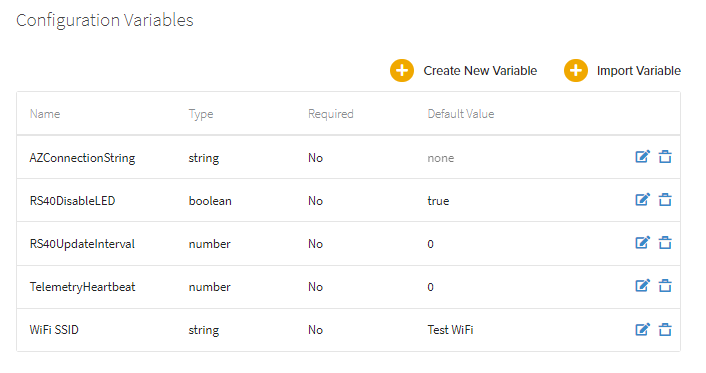
Gateways
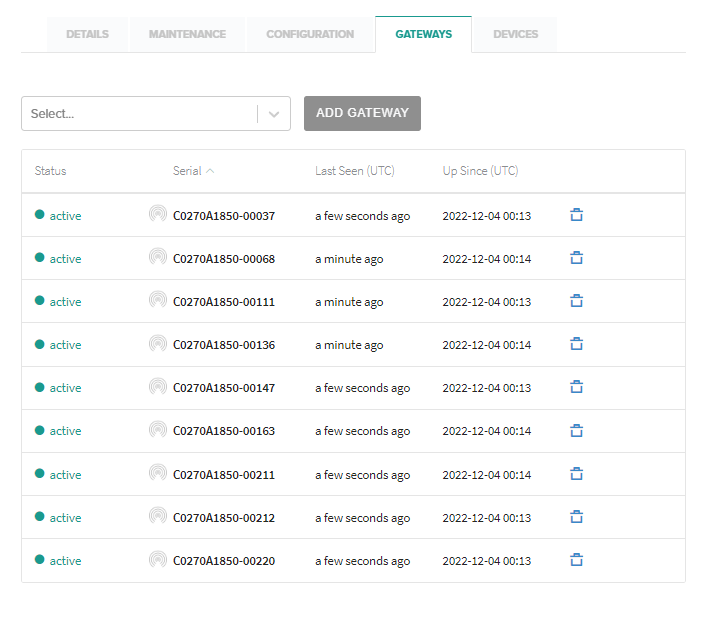
The Gateway tab of the Site detail view shows the current state of each Gateway in the Site. It allows a user to add new Gateways to the Site, and remove existing Gateways from the Site.
Clicking on a Gateway will take you to the Gateways Detail
Devices
The Devices tab of the Site detail view shows the current list of Devices and their status in the Site. Devices are automatically added and managed by Edge Connect Recipes. See Devices page here for more information.
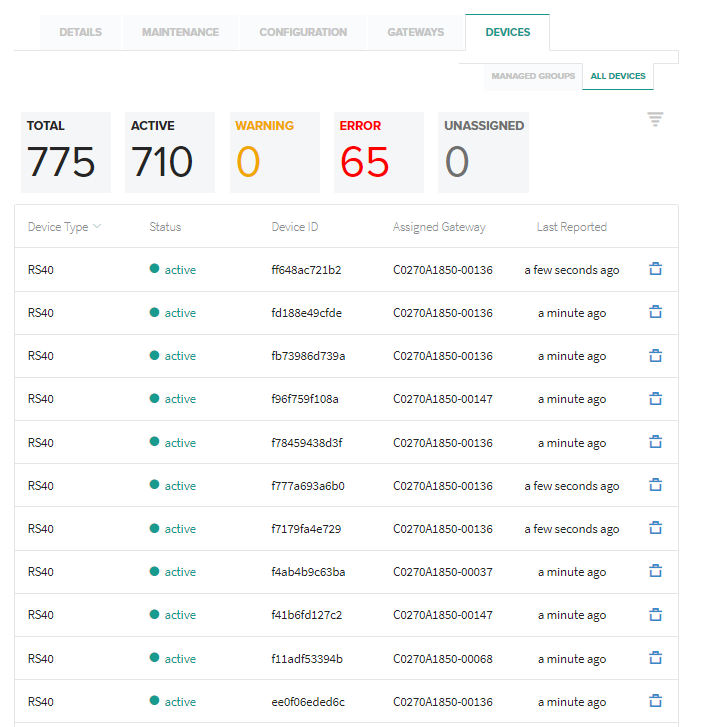
Devices that are no longer in use can be deleted from Edge Direct at the Site level by clicking the trash can symbol on the far right. This will delete all records of the Device inside Edge Direct and clear all health errors & warnings. However, it will not prevent the Device from re-populating if it is still present at the Site, or remove it from other Sites if it has been relocated.
Managed Device Groups
Managed Device Groups are Devices that have connectivity managed at the Site level by Edge Direct. Devices under management will get automatically assigned to the optimal gateway for connectivity to maximize uptime. Managed Devices automatically onboard, de-duplicate data coming from a single Devices being reported by multiple gateways and reroute Devices for network failover.
The Managed Device Group view gives you a more organized and detailed view of Devices sorted by type. By clicking on a group, you will navigate to a full list of all Devices in that group with useful information. Selecting any of those devices will open a detail view for that Device with information about its current assignment and connectivity information.
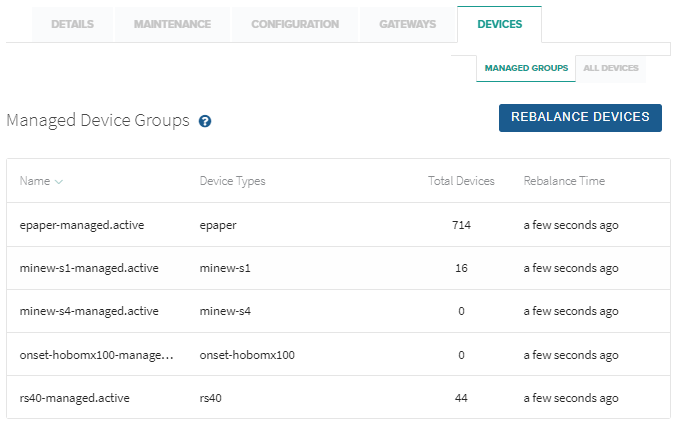
Rebalancing of Device assignment to Gateways can be manually triggered at any time by using the Rebalance buttons at the individual Group level or entire Site level when desired in this menu. Manual Rebalancing is useful and recommended after initial installation or major network/power outages if devices are having issues reconnecting to the network.
Creating a new Site
When creating a new Site, you are required to enter a new unique Site name. This cannot be changed after creation. It also prompts you to enter in details for Description, Location, and Time Zone.
Once you create a Site, you will not be able to rename it.
At the time of creation, you can also set a Maintenance Window. It is recommended to set a Maintenance Window for all production Sites, however once you set one any changes made to configurations won't apply to Gateways until the next window opens. Any Gateways added to the Site will automatically update to the current released Site configurations regardless of the Maintenance Window being set.
Lastly, there is the option to duplicate configurations from another existing Site. This is highly recommended to do at Site creation for consistency. It is recommended to create a Template Site that holds the latest production released configurations for your solution, and to copy from that for all new Sites.
Site can duplicate configuration in two modes:
Basic Simply copies all configuration sections.
Advanced Allows you to choose specific configuration types to copy individually.
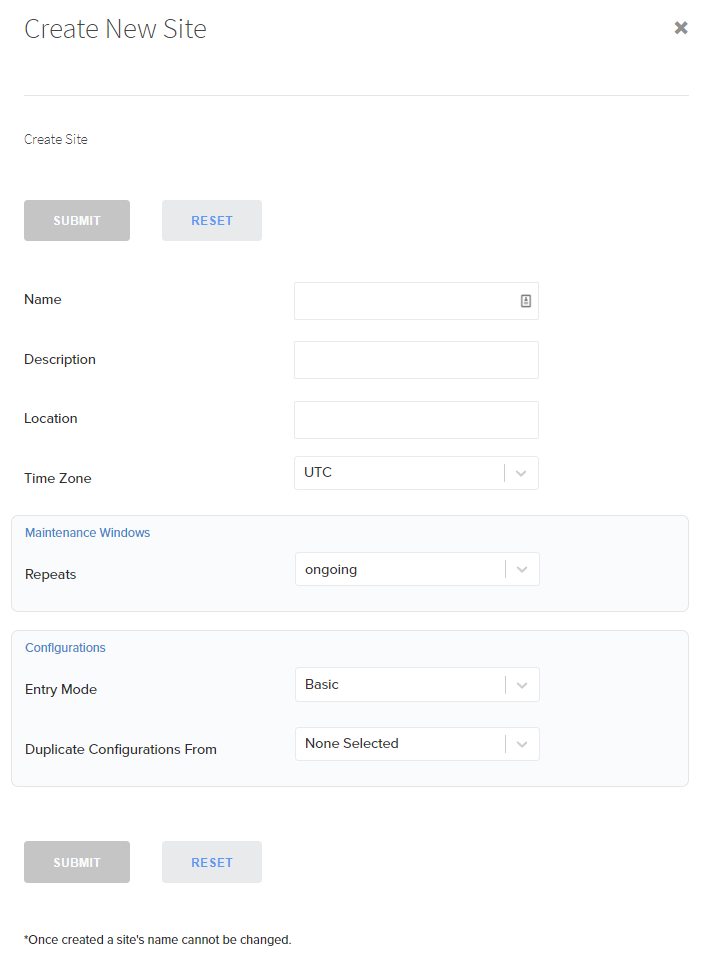
Updated 4 months ago
